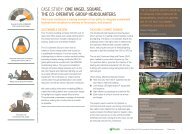Sustainable
Case study - Building a sustainable future - BAM
Case study - Building a sustainable future - BAM
- No tags were found...
Create successful ePaper yourself
Turn your PDF publications into a flip-book with our unique Google optimized e-Paper software.
<strong>Sustainable</strong> design<br />
Reduce energy<br />
consumption<br />
01<br />
02<br />
Pioneering more sustainable designs by Maximising efficiency through ‘passive<br />
design’ and developing innovative solutions to exceed our customers’ expectations.<br />
Reduce waste<br />
Reducing our impact<br />
Reduce<br />
environmental<br />
impact<br />
03<br />
04<br />
05<br />
06<br />
www<br />
Building a <strong>Sustainable</strong> Future 2012 | BAM Construct UK<br />
Making a positive impact<br />
We design our buildings to have a positive<br />
impact during the construction and<br />
operations phase and actively seek to<br />
reduce resource usage, waste and carbon<br />
emissions across their life cycle. To support<br />
our customers to meet reduction targets,<br />
save money and meet environmental goals,<br />
passive design is used where possible. We<br />
also consider the impact of the materials<br />
used within the building’s fabric, while also<br />
encouraging sustainable procurement<br />
throughout our supply chain.<br />
Collaborative working<br />
Collaboration is central to delivering a<br />
successful project and we work alongside<br />
our customers to understand their<br />
drivers, such as a need to meet legislative<br />
requirements, increase cost savings,<br />
enhance their brand or achieve LEED/<br />
BREEAM accreditation. Our collaborative<br />
approach is supported by BIM (building<br />
information modelling) which is used on all<br />
of BAM’s projects. It provides 3D models,<br />
visualisations and in-depth data sets,<br />
which enable the design team and key<br />
stakeholders to work together to make the<br />
building more resource and cost efficient,<br />
while also helping them to understand<br />
the impact of their choices in terms of<br />
cost and environmental benefits. With this<br />
knowledge, decisions can be made quicker<br />
and with the confidence that the building<br />
will deliver the expected outcomes.<br />
Taking a long term view<br />
Our sustainable design approach does<br />
not stop at the construction phase and we<br />
continue to support customers and the<br />
end user during a building’s operational<br />
life. This long term involvement helps us<br />
to understand how our buildings function<br />
over time and what we can do to improve<br />
their performance. These post occupancy<br />
evaluations are providing us with valuable<br />
insight which can be fed back into future<br />
projects to ensure we foster our culture of<br />
continuous improvement.<br />
We recognise that customer requirements<br />
change over time and our sustainable<br />
design approach helps them to meet<br />
future challenges head on. Buildings can<br />
be designed to provide flexibility so that<br />
services and room layouts can be altered to<br />
meet new requirements or tenants’ needs,<br />
while the BIM can be amended or enhanced<br />
over time to reflect modifications to the<br />
asset. The BIM can also show customers<br />
how an extension or alteration would impact<br />
the building’s performance, ensuring that<br />
sustainable goals can still be met.<br />
Next steps<br />
We are continuing to learn from post<br />
occupancy evaluations and plan to roll<br />
these out more widely across the business<br />
for new projects. And we are focusing<br />
on demonstrating our cradle to cradle<br />
approach to prove long-term end-user<br />
benefits thanks to the materials, designs<br />
and construction processes we utilise.<br />
Our development of BIM across the building<br />
life cycle will ensure that customers are able<br />
to achieve optimum levels of performance<br />
and realise the associated benefits. For<br />
example, we are currently working to link<br />
BIM to data collected and collated during<br />
the design and construction phases. This in<br />
turn will provide customers with exceptional<br />
operational data that can be used to deliver<br />
proactive maintenance and ensure that<br />
facilities perform as predicted.<br />
Collaborative working<br />
supported by BIM<br />
Benefits of BIM assist the business<br />
to reduce material waste and<br />
resources on projects<br />
Bid<br />
Design<br />
In use<br />
Construction<br />
Our team provides support<br />
throughout project life cycles<br />
View our <strong>Sustainable</strong> Design case study



